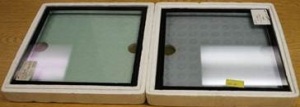“Carbon black, also called charcoal black lamp black, pigment black, soot or black carbon, is a fine particle carbon pigment obtained as soot from the incomplete combustion of many different types of organic materials, such as natural gas, or oil. Carbon black is usually a fine, soft, black powder. It is very stable and unaffected by light, acids and alkalis. It is commonly used in printing and lithograph inks and in Chinese ink sticks. In industry, carbon black is used as a filtration material and a filler /pigment in coatings, rubber, plastics, paints, carbon paper, and crayons. Continue reading
Category Archives: Coatings
How can I use EasyMatch QC to measure Contrast Ratio Opacity?
Contrast Ratio Opacity measurement quantifies how opaque a sheet sample using two readings. One reading is taken with the black glass or light trap backing the sample at the port. The second reading is taken with the sample backed by a white tile or the white sample clamp insert. EasyMatch QC will prompt you for the proper backing when taking opacity measurements.
What are Hydrochromic or Hygrochromic Color Samples?
Both “hydro” coming from Greek origins for water and “hygro” coming from the Greek “hygrós” for wet or moist, tend to be used in two terms for the same optical phenomena.
What is the technique for quantifying reflected color in architectural glass?
In the two glass window panes above you can probably notice a difference in the transmission color between the two. The one on the left appears greener while the one on the right appears bluer. There is another difference; the two samples have a difference in reflectance as well. The sample on the left has a reddish/purple reflectance color whereas the one on the right has a slightly bluish reflectance color.
Is it possible to quantify this difference in reflectance color on a transparent sample such as these architectural glass panels? Yes Continue reading
What is a Y Brightness? Beta Reflectance Factor? Reflection Coefficient?
FAQ: What is a Y Brightness/Luminance?
FAQ: What is a Beta (ß) Reflectance or Luminance Factor for Brightness?
FAQ: What is a Reflection Coefficient (0-1)?
Continue reading
Contrast Ratio Opacity
When used with industrial and commercial products, there is more than one definition of “opacity” as an optical property.

